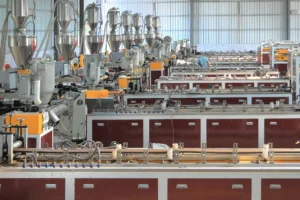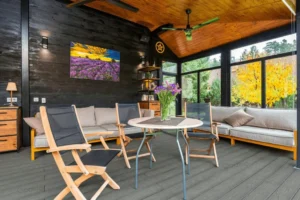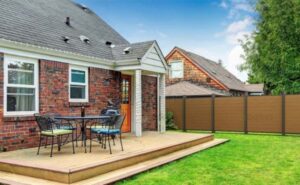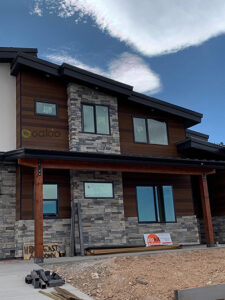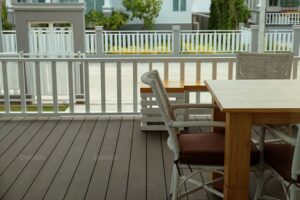Advances in the Use of Wood-Plastic Composites in Architectural Decoration
Wood-plastic composites (WPCs) are an innovative material designed to replace traditional building decoration materials. These composites combine plant fibers (such as peanut shells, wood chips, bamboo chips, etc.) with high-polymer plastics (like polyethylene and polypropylene), along with various additives. The result is a durable, sustainable alternative to conventional building materials.
Natural Wood Feel with Added Durability
One of the most appealing aspects of WPCs is their ability to replicate the texture and wood grain of natural wood. Through processing and modern manufacturing techniques, WPCs maintain a similar aesthetic to traditional wood, fulfilling the demand for wood-like beauty in construction while offering several key advantages. The density of WPCs typically ranges from 0.6 to 1.4 g/cm³, with variations depending on the processing techniques and additives used.
Unlike natural wood, WPCs have low water absorption properties. Even when exposed to moisture, they exhibit minimal thickness expansion—less than 1%. After treatment, WPCs develop a protective layer that prevents water molecules from entering, making them resistant to water damage. Additionally, WPCs are highly wear-resistant, with a surface abrasion index of no more than 0.08. Their exceptional resistance to corrosion extends their lifespan compared to traditional building materials.

Superior Flexibility and Mechanical Properties
WPCs offer excellent bending strength, with static bending strength typically exceeding 20 MPa and a bending modulus above 1800 MPa. Compared to traditional wood, WPCs have superior nail-holding ability. The material also exhibits excellent processing capabilities, allowing it to be sawed, nailed, planed, and glued. This ease of installation makes WPCs a convenient option for construction projects, saving both time and labor.
Moreover, WPCs are highly adjustable. Additives can be incorporated during production to alter the composite’s strength and density, enabling the material to meet specific requirements such as flame retardancy, anti-aging properties, and static resistance. The versatility of WPCs allows manufacturers to customize them for various purposes, making them suitable for a wide range of applications in construction and decoration.
Environmentally Friendly and Cost-Effective
WPCs are also eco-friendly, as they are made from a mix of polymer plastics and plant fibers. Many of the raw materials, such as recycled plastics, sawdust, and wood waste, are inexpensive and widely available. This helps lower the production cost of WPCs compared to traditional wood materials. Additionally, WPCs do not contain harmful chemicals like ammonia, formaldehyde, or benzene, ensuring they are free of pollutants and safe for both human health and the environment.
Because WPCs are made from recycled materials, they are also recyclable themselves, further contributing to sustainability. Their ability to be recycled and reused after their life cycle adds to their environmental benefits. WPCs can also be customized with coloring agents to achieve a wide range of colors, offering a high degree of flexibility for interior and exterior designs.
Applications in Building Decoration
WPCs are increasingly being used in architectural decoration, particularly in wall paneling. When applied to residential or commercial spaces, these materials offer a durable, aesthetically pleasing alternative to traditional wood and other materials. WPCs are commonly used in both exterior and interior wall cladding, particularly in prefabricated buildings. Popular types of WPCs include hollow exterior wall panels, exterior cladding panels, and hollow exterior decorative boards.
For exterior decoration, WPCs are often chosen for their ability to withstand the elements. They are suitable for low-rise or mid-rise residential buildings, as they can be used in seismic-resistant wall designs with anti-cracking properties. WPCs also meet fire-resistance standards, as outlined in building safety regulations. When used in interior spaces, WPCs are often employed as lightweight foam panels, providing both insulation and aesthetic appeal.
In combination with steel framing systems, WPC panels can contribute to the overall fire resistance of walls and help improve the performance of the building envelope. The use of WPCs in wall systems enhances the durability and environmental performance of the building while meeting modern architectural standards.
Conclusion
Wood-plastic composites are paving the way for a more sustainable and cost-effective approach to building decoration. With their ability to mimic the beauty of natural wood, combined with enhanced durability, flexibility, and environmental benefits, WPCs are proving to be a game changer in the construction industry. As the demand for eco-friendly, low-maintenance materials continues to grow, WPCs are poised to play a significant role in the future of architectural decoration.
Trending Reading
What Are the Differences Between the WPC Board and PVC Board?
[2024 Update] How Long Does WPC Decking Last?

